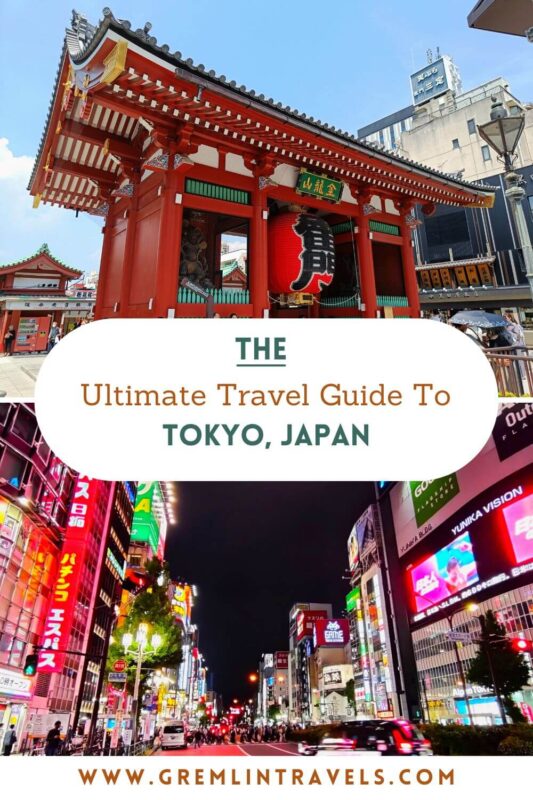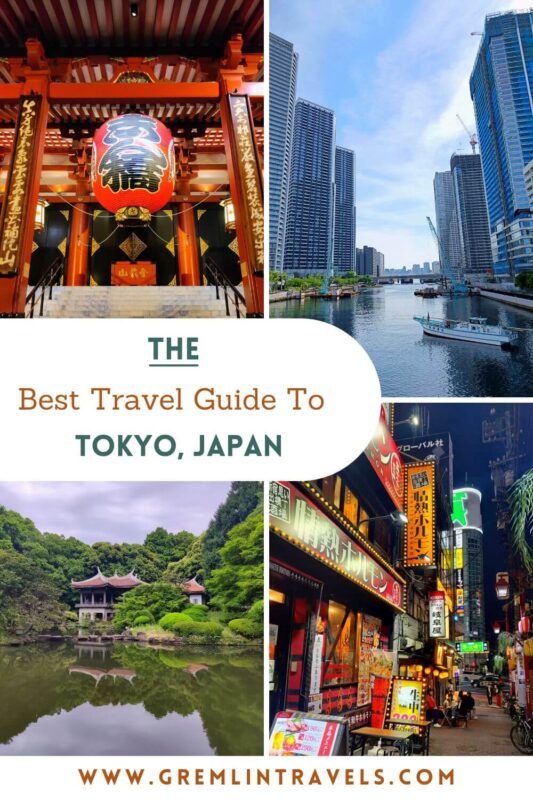Tokyo
Travel Guide
Welcome to our Tokyo travel guide where we discover how to explore Japan’s iconic capital city. Tokyo is more than just a city, it’s a gigantic sprawling metropolis that acts as the gateway to Japan, for most visitors. From traditional shrines and gardens to vibrant back alleys and towering skyscrapers, Tokyo offers a slice of almost every element of Japanese culture in one setting. Is this the best city in the world? There is only one way to find out.
There is no doubt about it, Tokyo can be daunting. It is a megacity and is made up of several smaller cities but this is, in part, why the city is so epic and unlike almost any other city in the world. Connected by a series of efficiently run subways and trains, getting around Tokyo takes a little getting used to, but is incredibly convenient. Thanks to Tokyo’s incredible public transport, visitors to the city can explore a plethora of neighbourhoods in next to no time, from the traditional areas of Asakusa and Ueno to the glamorous districts of Ginza and Roppongi and top it off with neon lights, late night bars and city views in the likes of Shibuya and Shinjuku. While a little bit of culture shock is relatively normal for most visitors, Tokyo’s incomparable convenience and efficiency make settling in easy. Whether it’s art, fashion, culture, shopping, museums, architecture, the outdoors, history or technology you are looking for, it’s in Tokyo. Maybe it’s hidden down a small back street or at the top floor of a skyscraper, but it’s there and finding it is part of the journey in the maze that is Tokyo. Lastly, let’s not forget the food, one of the top highlights of visiting Japan. Tokyo has thousands upon thousands of restaurants, something to suit every budget and taste from tiny ramen joints to Michelin-star restaurants and while they differ greatly, one thing is for sure most are consistent and most are good. You will never be far from a good restaurant, which has a lot to say for itself. If we know one thing, it’s that we love Japan, and we love Tokyo, and once you visit, explore and love Tokyo too, you will compare every other city in the world to Tokyo.
Tokyo Travel Guide Contents
Check out our other Japan Travel Guides:
Fukuoka Travel Guide | Hiroshima Travel Guide | Kyoto Travel Guide | Osaka Travel Guide | Okinawa Travel Guide | Sapporo Travel Guide
Tokyo Travel Guide
How to get to Tokyo
In the largest city in the world, there are multiple options for arriving in Tokyo but we will cover the most popular two here. There are two major airports serving Tokyo city, which are Tokyo Haneda Airport (HND) and Tokyo Narita Airport (NRT). Haneda Airport is located around 15km from central Tokyo, while Narita Airport is located around 60km from central Tokyo, but both have excellent public transport links. Both airports serve international and domestic flights so which airport you fly into or out of largely depends on the airline you are using. Narita and Haneda are large airports and, whichever you end up using, there are many shops, restaurants and cafes available as well as airport hotels, lounges, luggage delivery services and various other services and facilities. Here are the best options for getting to Tokyo from the airport:
By Train From Haneda Airport – There are two train options from Tokyo Haneda Airport: the Tokyo Monorail or the Keikyu Line. Both lines have frequent departures daily from around 05:15 to 23:45. The Tokyo Monorail line runs from terminals 1,2 and 3 to Hamamatsucho Station in 20 minutes, costing ¥500 ($3.75) per person. From Hamamatsucho Station there are connections to the JR Yamanote Line, Asakusa subway line and Oedo subway line. The Keikyu Line runs from terminal 3 to Shinagawa Station in 20 minutes, costing ¥300 ($2.25) per person. From Shinagawa Station, there are connections to the JR Yamanote line. The Keikyu line also converts to the Asakusa subway line at Shinagawa so, if you’re heading to Asakusa Station, you can get a direct train straight from Haneda Airport. Tickets for the train can be bought at Haneda Airport train station or buy an IC Card, top it up, and you can tap in and out with this which is generally far more convenient
By Bus from Haneda Airport – Several limousine buses depart Haneda Airport terminals and go directly to train stations and hotels across Tokyo. Limousine buses take a little longer but are generally easier with large luggage and offer direct connections so can be a convenient way to get around for many. Limousine bus timetables vary depending on the destination but they generally run every 30 to 60 minutes from around 07:00 to 00:00 from the airport, leaving earlier from the city to the airport. As a guide, a limousine bus from Haneda airport to Tokyo station will take around 45-55 minutes depending on the time of day and will cost ¥1000 ($7.50) per person. A limousine bus from Haneda airport to Shinjuku station will take around 45-55 minutes, depending on the time of day and will cost ¥1300 ($10) per person. Check the limousine bus website for timetables and fare information.
By Taxi from Haneda Airport – Taxis are available outside arrivals at Tokyo Haneda Airport and are available 24 hours a day. The price for a taxi into Tokyo can vary greatly depending on where you are heading but will cost somewhere between ¥5,000 and ¥11,000 ($38-$82) to some of the most common tourist areas. As a guide, a taxi to Shinjuku will take around 30 minutes, depending on traffic and the time of day, while a taxi to Tokyo Station will take around 20 minutes. a 20% surcharge is added between the hours of 22:00 and 05:00. Many taxis in Tokyo will now accept card payment but it’s a good idea to check beforehand and have cash with you as a backup. If your flight is arriving or departing in the early hours of the morning, your only option will be to take a taxi or stay in a hotel at the airport
By Train from Narita Airport – Four train lines depart from Narita Airport to the city relatively quickly and with ease. For getting to Tokyo Station and onwards to Shibuya or Shinjuku, take the JR Narita Express (NEX) which takes around 60 minutes to Tokyo station and costs ¥3100 ($23.25) per person. JR Narita Express trains depart every 30-60 minutes from around 07:30 to 22:00. For a cheaper alternative on the same line, take the JR Sobu line which departs every 60 minutes and takes 85 minutes to Tokyo Station, costing ¥1300 ($9.75) per person. Change at Tokyo station for trains to Shibuya, Shinjuku etc. For getting to Ueno and nearby areas, take the Keisei Skyliner which departs every 20-40 minutes from Narita Airport and takes 40 minutes to Ueno, costing ¥2570 ($19.25) per person. A cheaper alternative is the Keisei main line train which runs regularly throughout the day and stops at many stations along the route. The journey to Nippori or Ueno takes approx 75-90 minutes and costs ¥1050 ($8) per person. Tickets for trains are available at the station from the machines or the desk. For local commuter trains (JR Sobu line or Keisei Main Line) you can use an IC card but for the Narita Express and Keisei Skyliner, it is recommended to buy a ticket because the far is a little confusing with IC card payment
By Bus from Narita Airport – Limousine buses run directly from Narita Airport to many of the largest and most popular stations and hotels in Tokyo. They are clean, spacious and generally a good option for those with large luggage and those wanting to avoid changing trains. Limousine bus timetables vary depending on the destination but they generally run every 30 to 60 minutes from around 07:00 to 00:00 from the airport, leaving earlier from the city to the airport. As a guide, a limousine bus from Narita airport to Tokyo station will take around 90 minutes depending on the time of day and will cost ¥3200 ($24) per person. A limousine bus from Narita airport to Shinjuku station will take around 120-135 minutes, depending on the time of day and will cost ¥3200 ($24) per person. Check the limousine bus website for timetables and fare information.
By Taxi from Narita Airport – As Narita Airport is 60km outside of Tokyo, a taxi from the airport to central Tokyo is very expensive and not advisable. Taxies are available 24 hours a day from outside arrivals. A taxi from Narita airport into the city centre will cost in the region of ¥30,000 ($225), depending on the time of day and traffic. A better option would be to book a private transfer in advance which will generally be less expensive, we recommend looking at transfers available on Viator
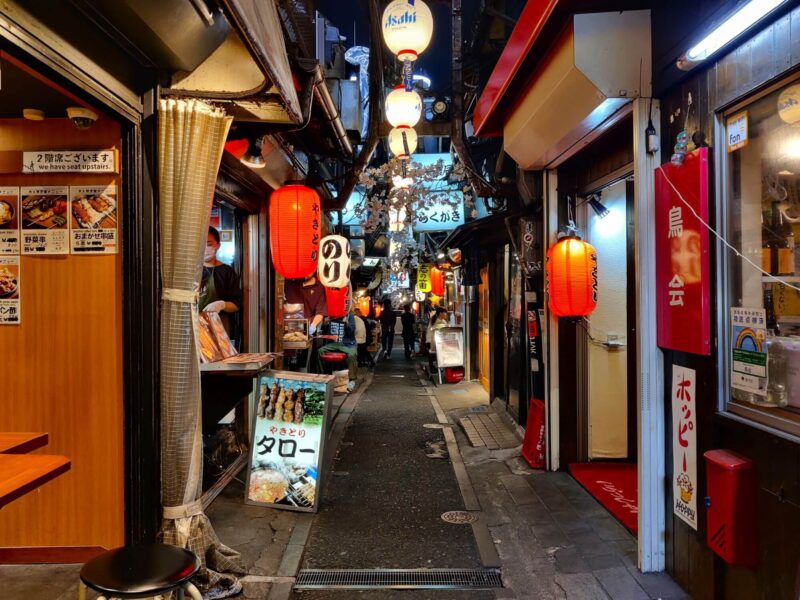
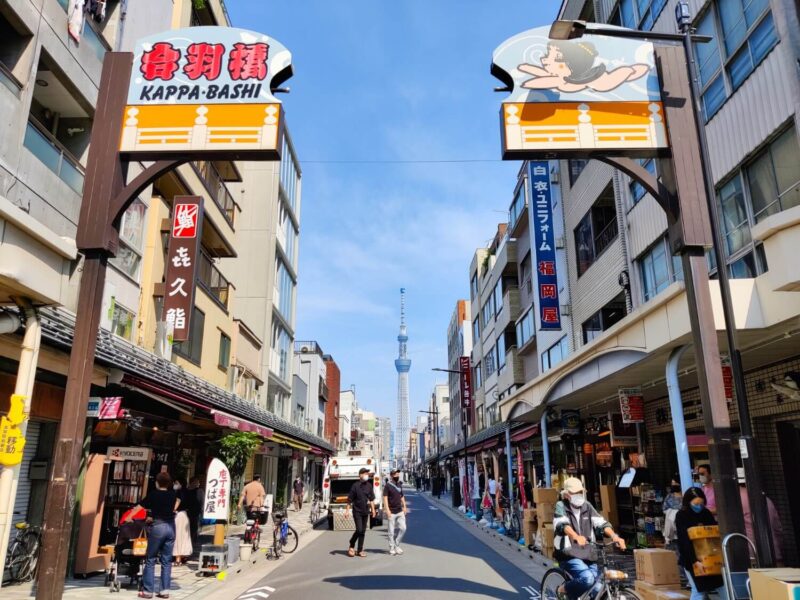
Areas to stay in Tokyo
Tokyo is a mega city. It’s made up of many smaller cities that combine to make the metropolis known as Tokyo. As a result, staying in an area that is convenient for your needs is incredibly important and can really make or break a stay in Tokyo. So, we’ve put together this quick guide to the best areas to stay in Tokyo to help you plan your visit:
Tokyo Station – Located in eastern Tokyo, this area is probably one of the most convenient areas to stay in Tokyo, largely because of Tokyo Station, Tokyo’s transport hub, which has a Shinkansen line running to Osaka, Kyoto, Hiroshima and western Japan and the north of Japan, as well as many of the cities train and metro lines, including the JR Yamanote loop line. This area is relatively close to Ginza, Nihonbashi and has quick connections to Ueno, Shinjuku and Shibuya. With tons of restaurants, and shops and within walking distance of the imperial palace and the central parks of the city, this is a great area for first-time visitors to Tokyo
Shinjuku – Located on the western side of Tokyo, Shinjuku is one of the most vibrant, busy and modern parts of Tokyo. The neon lights and towering buildings of Shinjuku are what many visitors to Tokyo will be dreaming of before visiting. Shinjuku station is a major transport hub in Tokyo and has train connections to much of the city including the JR Yamanote loop line, but you’ll need to connect to Tokyo station for the Shinkansen. There is an abundance of shops, restaurants and nightlife options in Shinjuku including the famous Golden Gai and it’s within walking distance of the National Garden and Meiji Jingu
Shibuya – Also on the western side of Tokyo, Shibuya is Tokyo’s coolest city, popular with younger people and home to countless shops, restaurants and nightlife options. It’s similar to Shinjuku and is equally as well-connected but slightly less busy. As well as being home to Shibuya crossing, Yoyogi park is also within walking distance from Shibuya
Asakusa – Situated on the northeastern side of Tokyo, Asakusa is a great option for those wanting to experience the more traditional side of Tokyo. Asakusa is home to Senso-ji Temple and is a short distance from the Tokyo Skytree, Ueno and Akihabara, making it a convenient place to stay for getting to several of Tokyo’s top attractions. Asakusa station provides convenient metro and train links while the nearby Ueno station is home to the Shinkansen to northern Japan and the Yamanote line. This side of Tokyo may not be as glamorous as the western side of the city, however, there are still plenty of shops, restaurants and nightlife options and accommodation prices are generally less expensive
Ueno – Located close to Asakusa, mentioned above, Ueno is another great area to stay in Tokyo, particularly for those on a budget or wanting to see the older side of Tokyo. Ueno station is another major transport hub for Tokyo with access to several metro and train lines, as well as, the Yamanote loop line and the Shinkansen to northern Japan. Ueno is bustling with small restaurants, cafes, markets and shops and is within walking distance to Ueno park, Senso-Ji Temple, some of the largest museums in Tokyo and Akihabara
Ginza – Similar to the Tokyo Station area, Ginza is an up-market area of Tokyo that is one of the best areas in the city for shopping. It’s home to several shopping centres and the streets are wide and easy to walk around. There are also some great dining options in Ginza. Within walking distance is Tokyo Station so transport connections are convenient and nearby attractions include the Imperial Palace and Tsukiji fish market, both top sights to see in Tokyo
Accommodation in Tokyo
Tokyo has a huge range of accommodation options to suit almost every budget and every need. From capsule hotels and hostels to apartments, traditional Japanese ryokans and luxury hotels, there is something for everyone. Here are our top picks for accommodation in Tokyo:
Budget Hostel | UNPLAN Shinkjuku – Located in the heart of Shinjuku, just 15 minutes walk from Shinjuku Station, UNPLAN Shinjuku is a bright, airy and comfortable hostel with a selection of capsule-style dorm beds, private dorm doors and private double rooms. Facilities include a shared lounge and kitchen, a bar and clean shared bathroom facilities. A free and simple continental breakfast is also included
Budget Hostel | Wise Owl Hostels Shibuya – Wise Owl Hostel Shibuya is another solid budget choice for those wanting to stay in the heart of Tokyo and have a social space. The hostel is 15 minutes walk from Shibuya Station and features a shared lounge, a small shared kitchen space and a range of accommodation options including dorm beds and private rooms
Mid-Range Hotel | Nishitetsu Inn Nihonbashi – An affordable option, the Nishitetsu Inn Nihonbashi is a business-style hotel offering clean and small comfortable rooms and facilities including an optional breakfast and a coin laundry on site. Located 15 minutes walk from Tokyo station, the hotel is a great option for those wanting to explore the city from a reasonably priced base
Mid-Range Hotel | Ryokan Sawanoya – Ryokan Sawanoya is located in Yanaka, just a short walk from Ueno Park. It is a great option for those wanting to experience a traditional Japanese stay in the centre of Tokyo. Rooms are traditional and include tatami mats, futons and the option of a private bathroom. Other facilities include optional western or Japanese breakfast, coin laundry, public baths and friendly staff that will help you where needed
Mid-Range Apartment | Minn Ueno – One of our favourite accommodation options in Ueno, Tokyo, Minn Ueno offers a selection of self-catering apartments that have been tastefully designed and well-equipped for couples, groups and families. There are a variety of room options and the self-check-in is super easy. Located less than 10 minute’s walk from Ueno Station, this is a great option for those wanting more space for a reasonable price in the heart of the older area of Tokyo
High-End Hotel | Hotel K5 – For something different, look no further than Hotel K5, located just a 15-minute walk from Tokyo Station. Hotel K5 is a sleek, designer hotel offering beautiful rooms, a restaurant, cafe and bar and all the usual amenities expected of a 4-star hotel in Japan. There are a few different room options, all of which include a vinyl record collection for unwinding and an optional breakfast
High-End Hotel | Muji Hotel Ginza – Stay in the heart of Ginza, at the Muji Hotel Ginza, just a 10-minute walk from Tokyo Station. Aligned with the iconic style of Muji stores, the Muji Hotel features clean, crisp and contemporary rooms that are spacious and well-equipped. The hotel also offers an optional breakfast, a restaurant and a bar. This is a great option for those wanting to stay in the shopping district of Tokyo and appreciate the best of Japanese design
Luxury Hotel | Mandarin Oriental, Tokyo – For all-out luxury, stay at the Mandarin Oriental, Tokyo. Rooms are spacious and beautifully furnished with views overlooking Tokyo. The hotel features a spa, fitness centre, 9 restaurants and bars including a Michelin-star tapas restaurant and it’s connected to the train and subway station
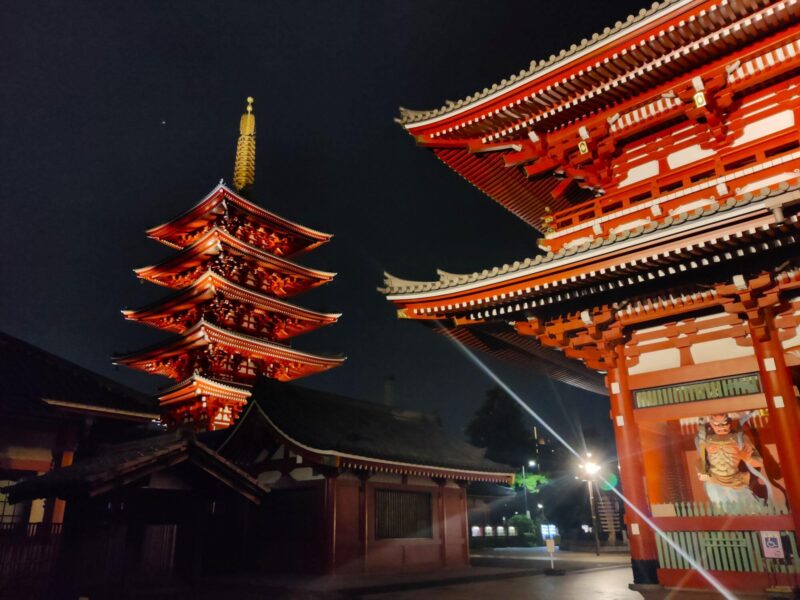
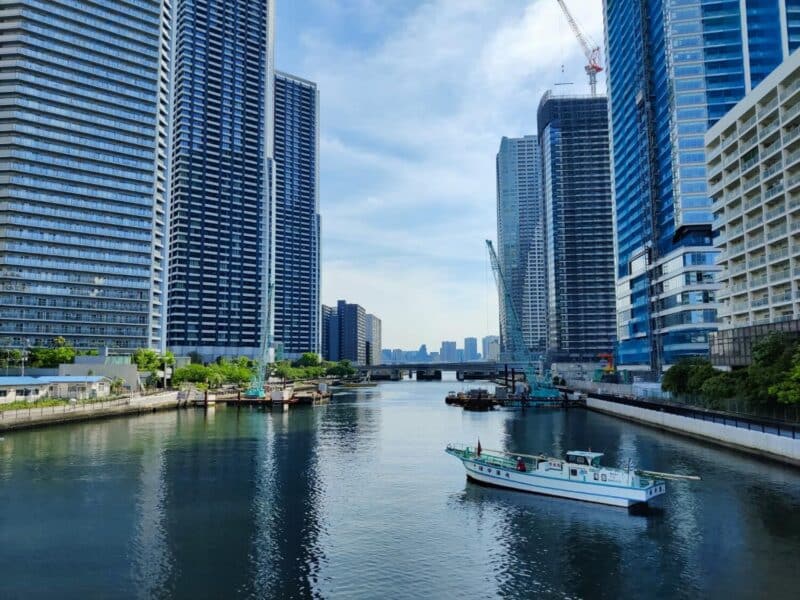
How to get around Tokyo
Tokyo has an extensive public transport network that travels to almost every part of the city and the gargantuan size of Tokyo means that you are likely to use it, at least a couple of times. It’s also one of the most complex transport networks that can take a little time to get used to, which many visitors don’t have the luxury of. One of our top tips is to use Google Maps. Google Maps is incredibly useful in Japan and within Tokyo, it will guide you through which train to get on, from where, which exit and entrance to use, when to change trains and lots more. We would also recommend getting an IC card when you arrive at the airport. An IC card is a top-up card which can be used for public transport in most major cities in Japan and also at convenience stores, vending machines and other outlets. The card makes changing trains so much easier, particularly when they are with different companies and have different gates. An IC Card costs ¥500 ($3.75) and is non-refundable and a minimum top-up amount of around ¥1500 ($11.25) is usually required initially. If you have one of the 10 most major IC cards in Japan from another city, you should be able to use this in Tokyo too. Here is our breakdown of the basics of Tokyo’s public transport network to help you know how to get around Tokyo:
Subway – Tokyo subway network is operated by two companies, Tokyo Metro with nine lines and Toei with four lines. The two combine to cover most of central Tokyo and further afield. Many of the subway line trains will convert to another train line at the last stop of the subway line so always know where and when you are getting off. The subway runs regularly every day from around 05:00 to 00:00, depending on the line. We recommend using a prepaid IC card for subway tickets but if you need to buy a ticket, these can be bought at stations from the desk or at the machines (available in English and other languages). Fares differ depending on the distance travelled but range from ¥170 ($1.30) to ¥320 ($2.50) and child fares are 50% less than adult fares
JR Trains – The largest train company in Japan, JR (Japan Railways) have 6 train lines in central Tokyo that are useful for getting around, especially for visitors that have purchased a JR rail pass. These trains combine with Tokyo’s extensive subway and train network to make travel across the city efficient, inexpensive and relatively easy. The six lines are the Yamanote line, Keihin-Tohoku line, Chuo Line, Sobu Line, Saikyo Line and the Shinkansen. The most useful of these is the Yamanote Line which is effectively a loop line around central Tokyo. For those that want to use public transport but find the transport network in Tokyo a little daunting, the Yamanote Line is a great way to get around as it stops at or near many of the top tourist attractions and loops, so it’s easy to know where you are and where you need to be. Trains on the Yamanote line run daily and regularly from 04:30 to 01:00, depending on the station and fares range from ¥140 ($1) to ¥200 ($1.50), depending on the distance travelled. IC cards can be used on these lines or tickets can be bought at the station at the desks or machines. Visitors with a JR Rail Pass can also use any JR line train in Tokyo with the pass
Trains – Alongside the subway and JR trains, 8 other train lines run from central Tokyo to outlying suburbs, these also include the trains mentioned in our airport transport section. While these trains can be useful for getting to further afield destinations and the airports, the subway and JR trains generally cover most areas for tourists. Fares vary depending on the type of train used (local, rapid, express) and the distance travelled, and can be paid by IC card or tickets can be bought at the station at the ticket desks or machines
Bus – As with any major city, Tokyo also has an excellent bus network covering the city. While buses can be useful for getting between areas that are less well connected by the train and subway network, it can be difficult to work out which bus you need and where to get it. For advice on getting a specific bus in Tokyo, we recommend asking a local for help or your hotel or the local tourist office. If you tell the driver where you want to get off, they will usually let you know when the bus gets there. Generally, we would recommend using the train and subway network in Tokyo which is much easier to navigate. Most buses operate a flat fare policy of ¥220 ($1.65) for adults and ¥110 ($0.85) for children and the fare can be paid by IC card or with change at the front of the bus. Check out bus routes across Tokyo on the Toei bus site
Taxi – Taxies in Tokyo can be a great option but they can also be pretty expensive when driving across such a large city. Taxi ranks exist at many train stations and popular tourist attractions and you can flag a vacant taxi on the street by raising your hand at them. Vacant taxis usually have a red sign on the screen and occupied taxis, have a green sign. One thing to remember is that the passenger doors in Japanese taxis are operated by the driver, so you don’t need to open or close them. The base taxi fare in Tokyo is ¥730 ($5.50) up to 2km and ¥320 ($2.40) for every kilometre thereafter. Prices increase by around 15-20% between 20:00 and 05:00 and a surcharge may be added for large luggage or tolls. Uber does also operate in Tokyo alongside other taxi apps
Things to do in Tokyo
There are tons of things to do in Tokyo from parks and shrines to museums and shopping, and deciding on a top 5 is practically impossible but we’ve tried our best, so if you’re in Tokyo here is a quick rundown of our top 5 best things to do in Tokyo:
Senso-ji Temple – Possibly one of the most popular things to see in Tokyo, Senso-ji Temple is an ancient Buddhist temple located in the traditional Asakusa district of Tokyo. It is the oldest temple in Tokyo and one of the most important. It is free to enter and has many souvenir shops lining the walkway down to the temple
Tokyo Sky tree – Towering above the Tokyo skyline, the Tokyo Sky tree is now one of the most iconic buildings in Tokyo. It is the tallest building in Japan and one of the tallest towers in the world. At the base is a large shopping centre and aquarium and at the top, two observation decks allow visitors to see across Tokyo like never before. Tickets for the floor 350 observation deck cost ¥2100 ($16) on weekdays and ¥2300 ($17.50) at weekends, access to higher views at floor 450 incurs extra costs
Shinjuku – There is no other area quite like Shinjuku and it’s a must-see for any visitors to Tokyo. Busy streets are lined with tall skyscrapers and big screens and in between lie small alleys with neon lights and tiny bars and restaurants. There is a lot to take in while in Shinjuku but walk the streets and be sure to check out Golden Gai, Omoide-Yokochō, Kabukicho and Okubo (Korea Town)
Shinjuku Gyoen National Garden – Located just outside of central Shinjuku, the Shinjuku Gyoen National Garden is one of the largest parks in Tokyo with 3 large ponds and a few cafes and restaurants. There are 3 main gardens, the Japanese garden, the English garden and the French garden, as well as, many cherry blossom trees and a large greenhouse. It’s a popular place, especially in the Sakura season and in the fall. Admission is ¥500 ($3.75) per person
Tsukiji Outer Market – Located in central Tokyo, Tskuji Outer Market lies outside the former Tskuji wholesale market which moved in 2018. The outer market remains and is home to a variety of shops and restaurants mostly focused on fish dishes and fish-related products and kitchenware. The market is set out over a few narrow alleys and most restaurants and shops open around 05:00 and close in the early afternoon. This is a great place to try fresh fish in Tokyo
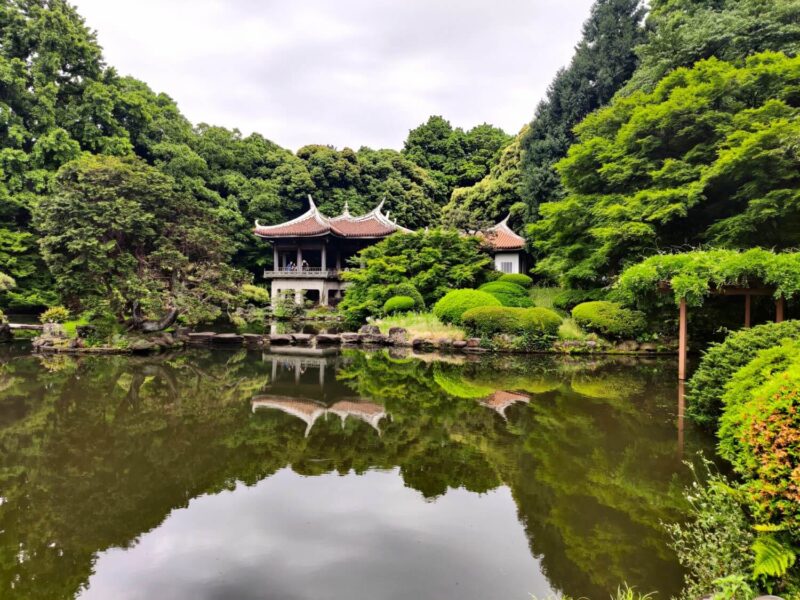
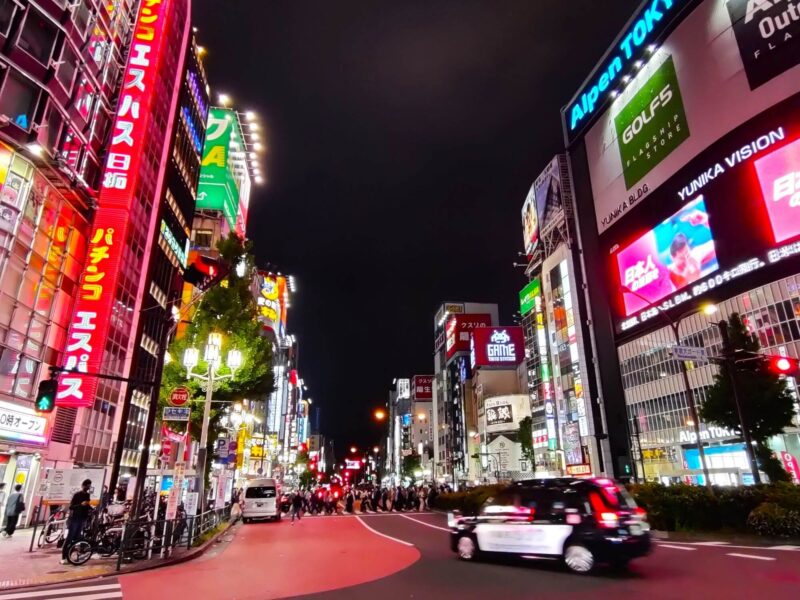
What to eat in Tokyo
Tokyo is home to over 100,000 restaurants, bars and cafes covering basically every cuisine imaginable. Of course, the most common types of restaurants are Japanese ranging from tiny ramen restaurants to buzzing izakayas, family diners and Michelin-star sushi bars. Food is generally of exceptional quality and no matter what you are craving, there will be somewhere serving it, if you look hard enough! Here are our top picks of what to eat in Tokyo, Japan:
Ramen – Probably one of the most well-known Japanese foods globally, Ramen is a must-have in Japan and is a hearty dish consisting of ramen noodles in a broth usually served with roasted pork and a small number of vegetables. Additional toppings such as an egg, nori and additional meat can be added. Three ramen broth bases are commonly used and ramen is usually eaten as a quick meal
Sushi – There are many ways of serving sushi including nigiri, maki, temaki, and futomaki. All involve rice with a topping or filling, commonly including raw fish and seafood and vegetables including cucumber and avocado. Try sushi at a local restaurant or opt for a conveyor belt experience at one of the large chains in Japan
Unagi – A delicious dish of Unagi is a must-have in Japan. Unagi is freshwater eel and the best way to have it is grilled and basted in a sweet savoury sauce and served on rice, known as kabayaki. It’s a little pricier than some Japanese dishes but completely worth it as there is nothing quite like it
Tempura – Tempura is lightly battered and deep fried pieces of, most commonly, seafood and vegetables, served with a tempura dipping sauce, and salt and served with either rice or noodles
Japanese Curry – Another globally known Japanese dish, the Japanese curry is a thicker, roux curry with spices. It is usually served with rice and can come in a variety of ways including a more traditional curry with beef, potatoes and carrots or with toppings including katsu pork, chicken or prawns
Money - Tokyo Travel Costs
The currency in Japan is the Japanese Yen (¥, 円 or JPY). Despite Japan’s reputation as a country of the future, cash is still the most common way to pay and many smaller shops, restaurants and bars will only take cash. Credit & Debit cards are usually accepted in larger stores and restaurants as well as chain restaurants, supermarkets and convenience stores. Paying by card in Tokyo is becoming easier but we would strongly advise having some cash to hand at all times, particularly for use in smaller stores and restaurants and for topping up your IC card. If you’re using a foreign credit or debit card, you can easily use ATMs within Japanese convenience stores (7-11, Familymart & Lawsons) to withdraw cash but do note that they always charge a small fee. Tipping is not required in Tokyo and can even be considered rude in some cases. Prices in the centre of Tokyo can vary from expensive to budget but are generally very reasonable and you can find good accommodation options and dining options that are far better value than in most developed cities. Here’s a quick guide for what you can expect to pay (per person) in Tokyo for:
A local draught beer – ¥400 – ¥800 ($3-$6)
A coffee – ¥400 – ¥700 ($3-$5.50)
An onigiri (Japanese rice ball snack) – ¥100 – ¥200 ($0.75 – $1.50)
Budget restaurant meal – ¥900 – ¥1500 ($7 – $12)
Mid-range restaurant meal – ¥2000 – ¥4000 ($15 -$30)
High-end restaurant meal – ¥5000 + ($38+)

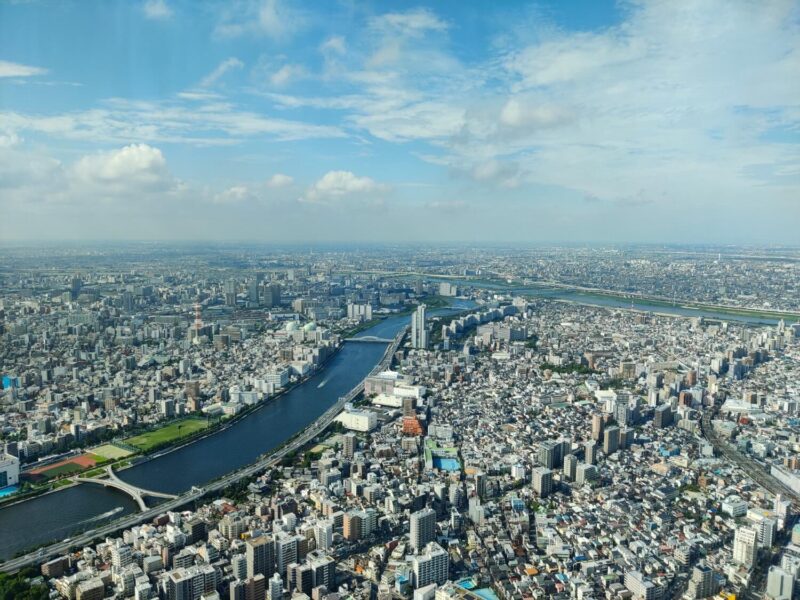
When to go to Tokyo and for how long
There is so much to do in Tokyo that you could probably spend a year there and still have so much to see, but we know that’s not realistic! So we would recommend spending around 4-5 days in Tokyo for most visitors to see most of the major sites and areas in the city. If you’re flying in and out of Tokyo then it can be good to split your time in Tokyo between coming in and out, so 3 days on your way in and 2 days on your way out. You could also stay on different sides of the city each time so that you can focus your sightseeing on one side, wasting less time on travel. If you’re in Japan for less time, for example; 1 week to 10 days, then we would recommend 2-3 days in Tokyo. Stay central, ideally near Tokyo Station so that you can easily get around the city to see the major sites.
Tokyo is busy year-round and there are always events on, so there isn’t a bad time to visit, however, we would recommend avoiding visiting in the New Year (1st-4th Jan) when many restaurants and shops close for the New Year holidays or during the height of summer (July-mid September) when the heat and humidity are practically unbearable in a large city. Cherry blossom season (Sakura is usually around the end of March to the beginning of April) is a beautiful time to visit Tokyo but prices of accommodation and flights can soar so for more reasonable prices and better weather visit from late April to early June or from late September to mid-November.
Local language and phrases
The language across Japan is Japanese, but being a major city and popular with tourists, help in English can be widely found across Tokyo. Many restaurants will have English menus or ordering by tablet available in English and transport hubs have English available on machines and usually have some English-speaking staff at desks. However, in smaller, more local-style establishments, English may be less widely spoken and available. In any case, it’s good to know a few key Japanese words and phrases when visiting Tokyo as the English language is not as widely used in the city as in many major cities and countries. We’ve put together a list of Japanese words and phrases that might be useful in our Japan guide so make sure you take a look before going
Tokyo travel tips
– Tokyo is a very safe city to visit and is safe for lone travellers, including lone females, as with all major cities, be mindful of scams, particularly in the nightlife districts of Roppongi and Kabukicho
– There are a growing number of cafes and restaurants that cater to vegan, vegetarian and gluten-free diets but research may be required to find them
– The tap water is safe to drink in Tokyo
– Check out our general Japan guide for tips on Japanese customs and manners to follow while visiting Tokyo
Tokyo travel guide written in December 2022
This site uses affiliate links. When you click on a link and purchase an item, we may be compensated on qualifying purchases. However, this is at no extra cost to you. See our affiliate disclosure for further information.
Tokyo Walking Tour Videos And Maps
Check out our Youtube Channel for more Tokyo walking tours, and tours for other destinations too.
Tokyo Nightlife Walking Tour
A walking tour video highlighting the sights and sounds of Tokyo’s Kabukicho district in Shinjuku at night with an accompanying map
Tokyo Ameyoko Walking Tour
A walking tour video highlighting the sights and sounds of Ameyoko market in Ueno, Tokyo with an accompanying map
Pin this Tokyo Travel Guide to save it for later!
